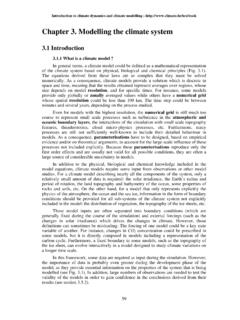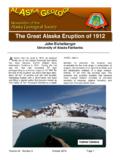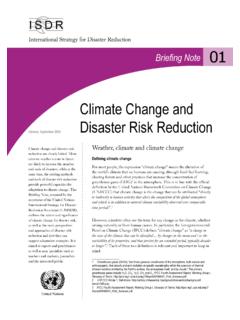Transcription of Chapter 1. Description of the climate system and its ...
1 Introduction to climate dynamics and climate modelling - Chapter 1. Description of the climate system and its components Introduction climate is traditionally defined as the Description in terms of the mean and variability of relevant atmospheric variables such as temperature, precipitation and wind. climate can thus be viewed as a synthesis or aggregate of weather. This implies that the portrayal of the climate in a particular region must contain an analysis of mean conditions, of the seasonal cycle, of the probability of extremes such as severe frost and storms, etc.
2 Following the World Meteorological Organisation (WMO), 30 years is the classical period for performing the statistics used to define climate . This is well adapted for studying recent decades since it requires a reasonable amount of data while still providing a good sample of the different types of weather that can occur in a particular area. However, when analysing the most distant past, such as the last glacial maximum around 20 000 years ago, climatologists are often interested in variables characteristic of longer time intervals.
3 As a consequence, the 30-year period proposed by the WMO should be considered more as an indicator than a norm that must be followed in all cases. This definition of the climate as representative of conditions over several decades should, of course, not mask the fact that climate can change rapidly. Nevertheless, a substantial time interval is needed to observe a difference in climate between any two periods. In general, the less the difference between the two periods, the longer is the time needed to be able to identify with confidence any changes in the climate between them.
4 Figure : Schematic view of the components of the climate system and of their potential changes. FAQ , figure 1 from IPCC (2007) using a modified legend, published in: climate Change 2007: The Physical Science Basis. Contribution of Working Group I to the Fourth Assessment Report of the Intergovernmental Panel on climate Change, Cambridge University Press, copyright IPCC 2007. Reproduced with permission. 1 Goosse H., Barriat, W. Lefebvre, Loutre and V.
5 Zunz (2010) We must also take into account the fact that the state of the atmosphere used in the definition of the climate given above is influenced by numerous processes involving not only the atmosphere but also the ocean, the sea ice, the vegetation, etc. climate is thus now more and more frequently defined in a wider sense as the statistical Description of the climate system . This includes the analysis of the behaviour of its five major components: the atmosphere (the gaseous envelope surrounding the Earth), the hydrosphere (liquid water, ocean, lakes, underground water, etc), the cryosphere (solid water, sea ice, glaciers, ice sheets, etc), the land surface and the biosphere (all the living organisms), and of the interactions between them (IPCC 2007, Fig.)
6 We will use this wider definition when we use the word climate . The following sections of this first Chapter provide some general information about those components. Note that the climate system itself is often considered as part of the broader Earth system , which includes all the parts of the Earth and not only the elements that are directly or indirectly related to the temperature or precipitation. The atmosphere Composition and temperature Dry air is mainly composed of nitrogen ( % in volume), oxygen ( in volume), argon ( in volume) and to a lesser extent carbon dioxide1 (380 ppm or in volume).
7 The remaining fraction is made up of various trace constituents such as neon (18 ppm), helium (5 ppm), methane1 ( ppm), and krypton (1 ppm). In addition, a highly variable amount of water vapour is present in the air. This ranges from approximately 0% in the coldest part of the atmosphere to as much as 5% in moist and hot regions. On average, water vapour accounts for of the mass of the atmosphere. On a large-scale, the atmosphere is very close to hydrostatic equilibrium, meaning that at a height z, the force due to the pressure p on a 1 m2 horizontal surface balances the force due to the weight of the air above z.
8 The atmospheric pressure is thus at its maximum at the Earth s surface and the surface pressure ps is directly related the mass of the whole air column at a particular location. Pressure then decreases with height, closely following an exponential law: zHsppe ( ) where H is a scale height (which is between 7 and 8 km for the lowest 100 km of the atmosphere). Because of this clear and monotonic relationship between height and pressure, pressure is often used as a vertical coordinate for the atmosphere.
9 Indeed, pressure is easier to measure than height and choosing a pressure coordinate simplifies the formulation of some equations. The temperature in the troposphere, roughly the lowest 10 km of the atmosphere, generally decreases with height. The rate of this decrease is called the lapse rate : Tz = ( ) where T is the temperature. The lapse rate depends mainly on the radiative balance of the atmosphere (see section ) and on convection as well as on the horizontal heat transport.
10 Its global mean value is about K km-1, but varies with the location and season. 1 The concentrations of carbon dioxide and methane are changing quickly (see section ). 2 1. Description of the climate system and its components The lapse rate is an important characteristic of the atmosphere. For instance, it determines its vertical stability. For low values of the lapse rate, the atmosphere is very stable, inhibiting vertical movements.







